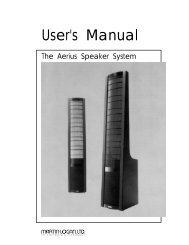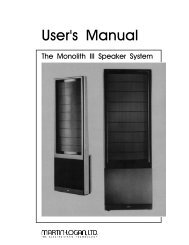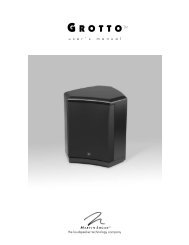PlacementListening PositionThe Side WallsEnglishBy now your speakers should be placed approximately twoto three feet from the front wall, the wall in front of the listeningposition, and about two feet from the side walls.Your sitting distance should be further than the distancebetween the speakers themselves. You are trying to attain theimpression of good center imaging and stage width.There is no exact distance between speakers and listener, butthere is a relationship. In long rooms, naturally, that relationshipchanges. The distance between the speakers will be far less thanthe distance from you to the speaker system. However, in a wideroom, you will still find that if the distance from the listener to thespeakers becomes smaller than the distance between the speakersthemselves, the image will no longer focus in the center.Now that you have positioned your speaker system, spend timelistening. Wait to make any major changes in your initial setupfor the next few days as the speaker system itself will changesubtly in its sound. Over the first 72 hours of play the actualtonal quality will change slightly with deeper bass and more spacioushighs resulting. After a few days of listening you can beginto make refinements and hear the differences.The Wall Behind the ListenerNear-field reflections can also occur from your back wall(the wall behind the listening position). If your listening positionis close to the back wall, these reflections can causeproblems and confuse imaging quality. It is better for thewall behind you to be absorptive than to be reflective. If youhave a hard back wall and your listening position is close toit, experiment with devices that will absorb information (i.e.wall hangings and possibly even sound absorbing panels).A good rule of thumb is to have the side walls as far away from thespeaker sides as possible. However, <strong>MartinLogan</strong>’s unique controlleddispersion electrostatic transducer inherently minimizesside wall reflections—a position as little as two feet from the sidewalls often proves adequate. Sometimes, if the system is bright orthe imaging is not to your liking, and the side walls are very near,try putting curtains or softening material directly to the edge ofeach speaker. An ideal side wall, however, is no side wall at all.ExperimentationToe-in—Now you can begin to experiment. First begin by toeingyour speakers in towards the listening area and then facingthem straight into the room. You will notice the tonal balanceand imaging changing. You will notice that as the speakers aretoed-in, the system becomes slightly brighter than when toedout.This design gives you the flexibility to compensate for a softor bright room.Generally it is found that the ideal listening position is with thespeakers slightly toed-in so that you are listening to the innerthird of the curved transducer section. A simple, yet effectivemethod to achieve proper toe involves sitting at the listeningposition, holding a flashlight under your chin and pointing it ateach speaker. The reflection of the flashlight should be withinthe inner third of the panel (see figure 3).Tilting the Speakers Backwards and Forwards—As thediagrams show in the Dispersion Interactions section of thismanual, the vertical dispersion is directional above and belowthe stator panel itself. In some instances, if you are sitting closeto the floor, slight forward tilting of the speakers can enhanceclarity and precision.The Wall Behind the SpeakersThe front surface, the wall behind the speakers, should not beextremely hard or soft. A pane of glass will cause reflections,brightness and confused imaging. Curtains, drapery and objectssuch as bookshelves can be placed along the wall to diffuse anoverly reflective surface. A standard sheet rock or textured wallis generally an adequate surface if the rest of the room is not toobright and hard. Walls can also be too soft. If the entire frontwall consists of heavy drapery, your system can sound dull. Youmay hear muted music with little ambience. Harder surfaceswill actually help in this case.The front surface ideally should be one long wall withoutany doors or openings. If you have openings, the reflectionand bass characteristics from each channel can be different.Imaging—In their final location, your Montis’s can have a stagewidth somewhat wider than the speakers themselves. On wellrecorded music, the instruments can extend beyond the edgesof each speaker (left and right), yet a vocalist should appeardirectly in the middle. The size of the instruments should be neithertoo large nor too small, subject to the intent and results ofeach unique audio recording.Additionally, you should find good clues as to stage depth. Makesure that the vertical alignment, distance from the front wall,and toe-in is exactly the same for both speakers. This will greatlyenhance the quality of your imaging.Bass Response—Your bass response should neither be onenote nor should it be too heavy. It should extend to the deepestorgan passages and yet be tight and well defined. Kick-drums24 Connections and Placement
should be tight and percussive—string bass notes should be uniformand consistent throughout the entirety of the run withoutbooming or thudding.Tonal Balance—Voices should be natural and full and cymbalsshould be detailed and articulate yet not bright and piercing,pianos should have a nice transient characteristic and deep tonalregisters. If you cannot attain these virtues, read the section onRoom Acoustics (pages 27–28). This will give you clues on howto get closer to these ideal virtues.Final PlacementAfter the full break in period, obtaining good wall treatments,and the proper toe-in angle, begin to experiment with the distancefrom the wall behind the speakers. Move your speakerslightly forward into the room. What happened to the bassresponse? What happened to the imaging? If the imaging ismore open and spacious and the bass response is tightened, thatis a superior position. Move the speakers back six inches fromthe initial setup position and again listen to the imaging and bassresponse. There will be a position where you will have pinpointimaging and good bass response. That position is the point of theoptimal placement from the front wall.0.618 = the distance from the front wall to the center of thecurvilinear transducer).2 Distance from the side-walls to the center of the curvilineartransducer: To determine distance from the side walls, measurethe width of your room in inches and divide by 18.Next, multiply the quotient by 5 (i.e. room width in inches /18 x 5 = the distance from the side-walls to the center of thecurvilinear transducer)Enjoy YourselfThe Montis is a very refined speaker and benefits from care insetup. With these tips in mind you will find, over your monthsof listening, that small changes can result in measurable differences.As you live with your speakers, do not be afraid toexperiment with their positioning until you find the optimal relationshipbetween your room and speaker system that gives toyou the best results. Your efforts will be rewarded.Now experiment with placing the speakers farther apart. As thespeakers are positioned farther apart, listen again, not so muchfor bass response but for stage width and good pinpoint focusing.Your ideal listening position and speaker position willbe determined by:• Tightness and extension of bass response• Width of the stage• Pinpoint focusing of imagingEnglishOnce you have determined the best of all three of theseconsiderations, you will have your best speaker location.The Extra “Tweak”This extra “tweak” may be useful when your speakers are placedin a dedicated listening room. Use the following procedure andmeasurements for your speakers placement to see what canhappen to your system’s performance. These formulas will helpdetermine optimum placement of your speakers to minimizestanding waves.1 Distance from the front wall (in front of the listening position)to the center of the curvilinear transducer: To determine distancefrom the front wall, measure the ceiling height (inches)and multiply the figure by 0.618 (i.e. ceiling height (inches) xFigure 2. Final placement.Placement 25






